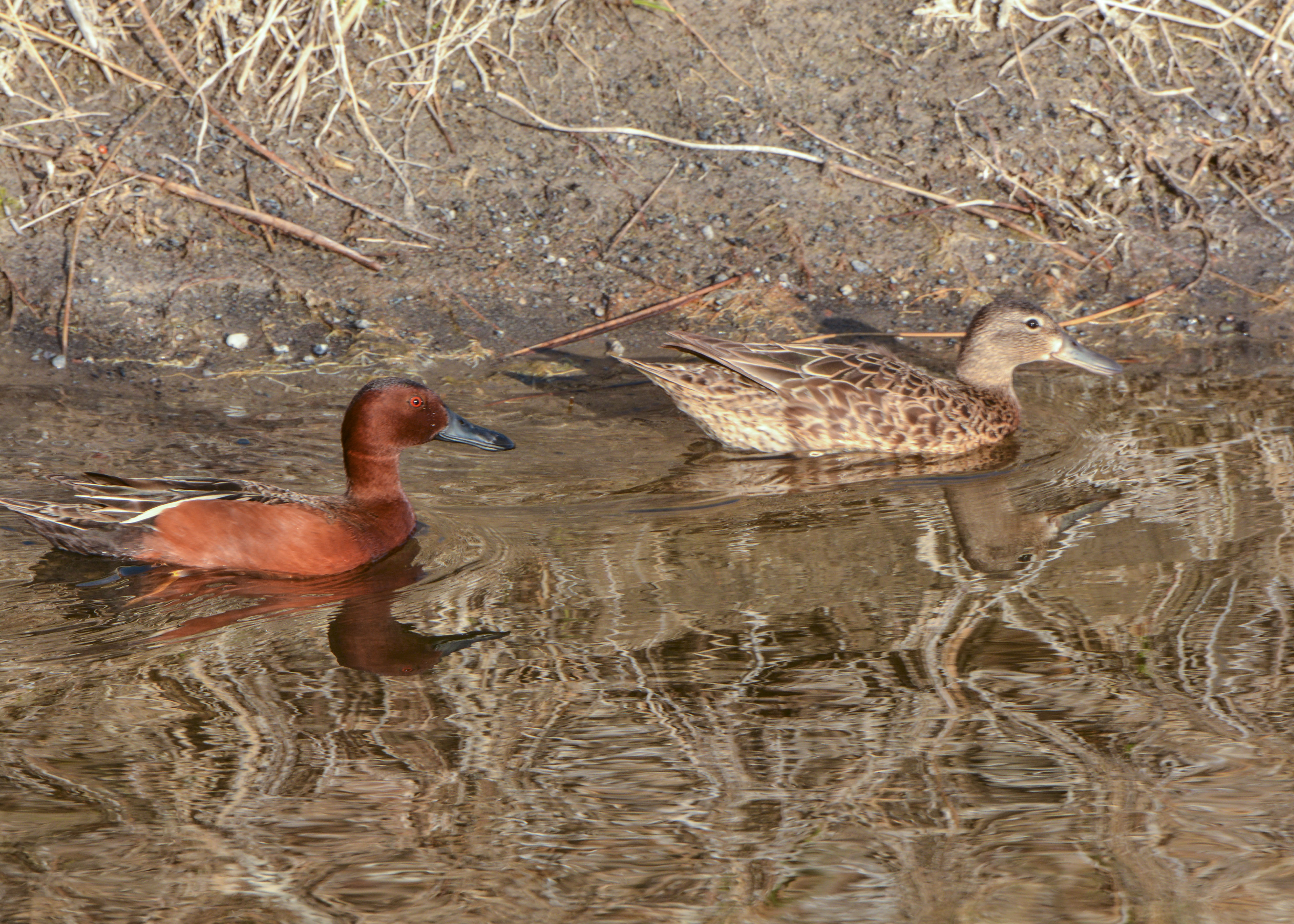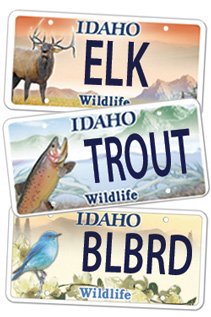Sexual Dimorphism

The male and female cinnamon teal almost look like they could be different species.
When springtime tints the landscape green, gentlemen callers, especially birds, will be dressed in their finest, sometimes hardly recognizable as the same species as the females they court. This is sexual dimorphism—differences between the sexes—at its finest. Sexual dimorphism takes many forms, but the usual is for the male to be the gaudy show-off and the female the earth-toned camouflaged one. Probably the best-known example is that of the peafowl, also known as the peacock; the male with a huge iridescent green fan for a tail and the brown-colored peahen, a seemingly different species. Other classic examples include the red-winged and yellow-headed blackbirds where the females resemble sparrows and look nothing like their male counterparts.
For some males, many of the ducks come to mind, display plumage is just a spring thing. They may look like a different species during breeding season, but from summer to fall they are in an eclipse plumage that resembles the female. Alternatively, white pelican males look like the females all year long except during breeding season. Then they grow a “horn” on the bill that may seem laughable to us, but is irresistible to female pelicans.
Other male birds, such as ring-necked pheasant and wild turkeys, are always in their “mating” plumage but add displays such as crowing, strutting and colorful facial wattles in season. Sage-grouse males inflate yellow air-sacs on their breasts during mating season and add long neck plumes to the display. With some songbirds such as cardinals and phainopeplas, the males are a more striking color but the same shape and size as females.
Many reptiles also get into the mating game through sexual dimorphism. The male green iguana, for instance, develops a striking orange tinge during mating season.
Even some male fish develop sexually dimorphic patterns. Male Kokanee salmon for instance, develop hook jaws and turn red during the spawning season. Male guppies develop spots during breeding.
Mammals are often far less ornamentally sexually dimorphic than say, birds. With its red and blue face, the mandrill male (a primate) is considered the most ornamentally sexually dimorphic mammal. It can also be four times larger than a female. Some of the most common mammal differences are antlers on males (female caribou have antlers too), fuller horn development on males, and size. In many mammals, the male is larger and stronger than the female, largely to be able to compete with other males for the right to breed.
In birds, size may be equal between sexes. Like mammals, if combat between males is involved, often the male is larger, but at least with raptors, the female is usually significantly larger.
Sexual dimorphism is all about breeding. Some of the strangest cases are the Birds-of-Paradise of New Guinea and Australia. This family, close relatives to crows and ravens, has 42 species, the majority of which are sexually dimorphic to the extreme. Some birds-of-paradise may have tails up to forty inches long. Others have cobra-like collars that they raise during display or long facial or neck feathers that dangle tantalizingly in front. They are so unique that they defy description.
All of this showing off has a single purpose for the male; to convince a female to mate with him. This may be done with sedate exhibitions, violent battles between males or highly ritualistic displays where the male must get things exactly right before a female will show interest.
Whether it is through female choice or male competition, breeding selection has driven animals to makeover extremes through time and has given us some delightful specimens to enjoy.
Help Idaho Wildlife
When we traveled across the state in October 2017, we visited most of the Idaho Department of Fish and Game wildlife management areas. Most of the vehicles we saw using the wildlife management areas did not have wildlife plates. Buying wildlife plates is a great way for non-hunters and hunters alike to support wildlife-based recreation like birding.
C'mon folks, let's help Idaho's wildlife by proudly buying and displaying a wildlife license plate on each of our vehicles!
See below for information on Idaho plates. Most states have wildlife plates so if you live outside Idaho, check with your state's wildlife department or vehicle licensing division for availability of state wildlife plates where you live.
And tell them that you heard about it from Nature-track.com!

Wildlife License Plates
Great news! as of 2024, there are three NEW designs for license plates. They still are bluebird, cutthroat trout and elk, but they are beautiful.
Idaho Wildlife license plates provide essential funding that benefits the great diversity of native plants and wildlife that are not hunted, fished or trapped—over 10,000 species or 98% of Idaho’s species diversity. Game species that share the same habitats (such as elk, deer, antelope, sage-grouse, salmon, trout) also benefit from these specialty plates.
No state tax dollars are provided for wildlife diversity, conservation education and recreation programs. Neither are any revenues from the sale of hunting or fishing licenses spent on nongame species. Instead, these species depend on direct donations, federal grants, fundraising initiatives—and the Idaho Wildlife license plates.
Both my vehicles have Bluebird Plates. I prefer the bluebird because the nongame program gets 70 percent of the money from bluebird plates, but only 60 percent of the money from elk and trout plates - 10 percent of the money from elk plates supports wildlife disease monitoring and testing programs (to benefit the livestock industry) and 10 percent from cutthroat plates supports non-motorized boat access.
Incidentally, in 2014, the Idaho Legislature denied the Department of Fish and Game the ability to add new plates or even to change the name of the elk and cutthroat plates (very specific) to wildlife and fish plates, a move that would have allowed for changing images occasionally and generating more revenue. It would seem that they believe that we Idahoans don't want a well funded wildlife program.
I think it is time we let the Legislature know that Idahoan support wildlife funding and that we would like to see these generic plates come to fruition.

"WOW. What a phenomenal piece you wrote. You are amazing." Jennifer Jackson
That is embarrassing, but actually a fairly typical response to my nature essays. Since The Best of Nature is created from the very best of 16 years of these nature essays published weekly in the Idaho Falls Post Register (online readership 70,000), it is a fine read. It covers a wide variety of topics including humorous glimpses of nature, philosophy, natural history, and conservation. Readers praise the style, breadth of subject matter and my ability to communicate complex and emotional topics in a relaxed and understandable manner.
Everyone can find something to love in this book. From teenagers to octogenarians, from the coffee shop to the school room, these nature essays are widely read and enjoyed.
Some of the essays here are my personal favorites, others seemed to strike a chord with readers. Most have an important message or lesson that will resonate with you. They are written with a goal to simultaneously entertain and educate about the wonderful workings of nature. Some will make you laugh out loud and others will bring a tear to the eye and warm your heart.
Readers Write:
"You hit a home run with your article on, Big Questions in Nature. It should be required reading for everyone who has lost touch with nature...great job!" Joe Chapman
"We enjoyed your column, Bloom Where Planted. Some of the best writing yet. The Post Register is fortunate to have your weekly columns." Lou Griffin.
To read more and to order a copy, click here or get the Kindle version
Copies are also available at:
Post Register
Island Park Builders Supply (upstairs)
Barnes and Noble in Idaho Falls
Harriman State Park, Island Park
Museum of Idaho
Valley Books, Jackson Wyoming
Avocet Corner Bookstore, Bear River National Wildlife Refuge, Brigham City, Utah
Craters of the Moon National Monument Bookstore, Arco, Idaho
Wildlife License Plates
Great news! as of 2024, there are three NEW designs for license plates. They still are bluebird, cutthroat trout and elk, but they are beautiful.
Idaho Wildlife license plates provide essential funding that benefits the great diversity of native plants and wildlife that are not hunted, fished or trapped—over 10,000 species or 98% of Idaho’s species diversity. Game species that share the same habitats (such as elk, deer, antelope, sage-grouse, salmon, trout) also benefit from these specialty plates.
No state tax dollars are provided for wildlife diversity, conservation education and recreation programs. Neither are any revenues from the sale of hunting or fishing licenses spent on nongame species. Instead, these species depend on direct donations, federal grants, fundraising initiatives—and the Idaho Wildlife license plates.
Both my vehicles have Bluebird Plates. I prefer the bluebird because the nongame program gets 70 percent of the money from bluebird plates, but only 60 percent of the money from elk and trout plates - 10 percent of the money from elk plates supports wildlife disease monitoring and testing programs (to benefit the livestock industry) and 10 percent from cutthroat plates supports non-motorized boat access.
Incidentally, in 2014, the Idaho Legislature denied the Department of Fish and Game the ability to add new plates or even to change the name of the elk and cutthroat plates (very specific) to wildlife and fish plates, a move that would have allowed for changing images occasionally and generating more revenue. It would seem that they believe that we Idahoans don't want a well funded wildlife program.
I think it is time we let the Legislature know that Idahoan support wildlife funding and that we would like to see these generic plates come to fruition.